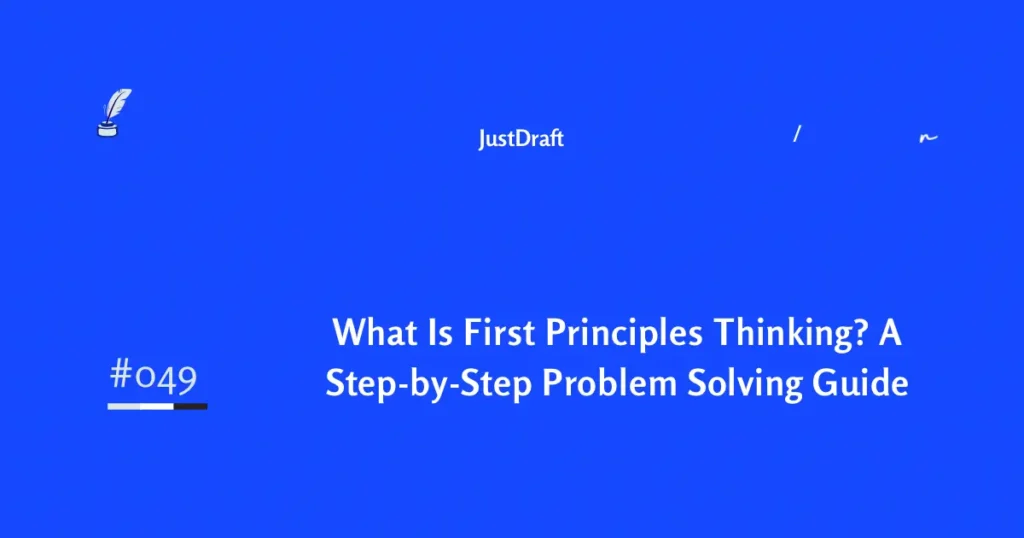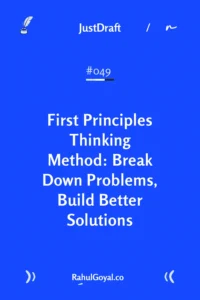How First Principles Thinking Helps You Solve Problems From Scratch
Remember when everyone said electric cars were too expensive to work? Or that private space travel was impossible?
Elon Musk didn’t accept these “truths.” He asked a different question: “What if we’re wrong about this?”
That’s First Principles Thinking. And it’s simpler than you think.
One Topic: What Is First Principles Thinking?
Imagine you’re buying a rocket. The price tag says $65 million. Everyone agrees that’s just what rockets cost.
But Musk asked: “What’s a rocket actually made of?”
Turns out, the raw materials—aerospace aluminum, titanium, copper, carbon fiber—cost only 2% of that price. The rest? Overhead, tradition, and the way things have always been done.
So he built SpaceX. Today, rocket launches cost 90% less than before.
That’s First Principles Thinking. You break things down to basic truths. Then you build back up without assumptions.
The Greek philosopher Aristotle called it “the first basis from which a thing is known.” It’s been around for 2,400 years. But most of us never use it.
Why Most People Think Backwards
Your brain loves shortcuts. It’s faster that way.
You see a problem. Your brain searches for similar situations. “This looks like that thing we did before.” You copy the solution. Done.
This is called analogical reasoning. It works fine for routine stuff. But it keeps you stuck when you need real innovation.
Here’s the difference:
- Analogical thinking: “Other companies do it this way, so we should too.”
- First Principles thinking: “Why do they do it that way? What if we started from scratch?”
Research shows that 75% of business decisions using analogical reasoning lead to poor outcomes. Why? Because you’re solving symptoms, not root causes.
The Three-Step Method
Musk breaks it down simply:
- List Your Assumptions: Write down everything you believe about the problem. Everything. “Electric car batteries are expensive.” “Rockets need to be thrown away after one use.” “Retail needs physical stores.”
- Break It Down to Basic Facts: Now ask: What’s actually true here? Tesla example: “Battery cells are made of nickel, cobalt, and lithium. These are commodity materials with known market prices.” That’s a fact. “Batteries must be expensive” was just an assumption.
- Build Something New: Using only the facts, ignore how it’s “always been done.” Tesla built Gigafactories. They achieved 20% cost reduction per year. Electric cars became affordable. Amazon did this with retail. Jeff Bezos asked: “What do customers actually need?” The answer: Selection, low prices, fast delivery. None of those need a physical store. So Amazon became the world’s largest retailer without one.
Why Your Brain Fights This
Your prefrontal cortex handles complex thinking. First Principles work happens there.
But it’s slow. It uses lots of energy. And when you challenge assumptions, your amygdala (fear center) gets nervous.
That’s why this feels uncomfortable. Your brain is literally trying to protect you from the unknown.
Albert Einstein knew this. He said: “If I had an hour to solve a problem, I’d spend 55 minutes thinking about the problem and 5 minutes on solutions.”
Most people do the opposite. They jump to solutions in 5 minutes.
When Should You Use This?
Not always. That’s important.
Use First Principles for:
- Big strategic decisions
- Problems where normal solutions keep failing
- Innovation opportunities
- Crisis situations
Don’t use it for:
- Routine decisions
- Time-sensitive situations
- Simple problems with known solutions
Your brain only has so much energy. Save this method for what matters.
The Five Whys Technique
This tool helps you find those fundamental truths.
Example: “I need to go to bed.”
Why? “Because it’s bedtime.” Why? “Because my body needs sleep.” Why? “Because I’d die without it.” Why? “Because my cells need time to repair.” Why? “Because that’s how biology works.”
Now you’ve hit a fundamental truth. You can’t reduce it further.
This works in business too. Keep asking why until you reach bedrock.
Real Examples That Changed Everything
Dyson Vacuums
Everyone knew: Vacuum cleaners need bags. James Dyson asked: Why?
He discovered cyclonic separation could work without bags. The entire industry said it was impossible.
Today Dyson is worth billions .
Netflix
Everyone knew: People need physical DVDs. Reed Hastings asked: Do they really?
Truth: People want to watch content. The delivery method doesn’t matter.
Netflix killed Blockbuster and changed how the world watches TV.
Apple iPhone
Everyone knew: Phones need keyboards for typing. Steve Jobs asked: What if the entire screen was the interface?
Truth: People need to input data. A keyboard is just one way to do it.
The iPhone created a over $2 trillion company.
How to Practice This
Start small. Pick one assumption in your work.
“We need to have meetings on Monday mornings.”
Break it down:
- Why Monday? (Assumption)
- Why mornings? (Assumption)
- Do we need this meeting at all? (Assumption)
- What problem is this actually solving? (Fundamental question)
Maybe you discover the meeting exists because it always has. That’s not a reason.
Or maybe you find a real need: “Team members need to align on priorities.”
Good. Now ask: “What’s the best way to align on priorities?”
Maybe it’s not a meeting at all.
The Socratic Questions
Ancient Greek philosopher Socrates had a method for finding truth:
- “Why do I believe this?”
- “How do I know this is true?”
- “What’s the evidence?”
- “What if I believed the opposite?”
- “What happens if I’m wrong?”
- “Why am I even asking this question?”
Use these when examining assumptions. They cut through surface thinking fast.
Common Mistakes
- Mistake 1: Confusing assumptions with facts – “Our customers want feature X” sounds like a fact. But have you tested it?
- Mistake 2: Using it for everything – Your brain will burn out. Reserve this for important problems.
- Mistake 3: Ignoring practical constraints – First Principles might say “build our own semiconductor factory.” But do you have $10 billion and three years?
- Mistake 4: Going solo – Different perspectives help you spot hidden assumptions. Get input from others.
Building This Skill
Your brain can rewire itself. Scientists call it neuroplasticity. Each time you practice First Principles Thinking, you create new neural pathways. It gets easier. But it takes time. Be patient with yourself.
Start with one problem per week. Work through the three steps. Document your reasoning.
Over time, this becomes natural. You’ll catch yourself questioning assumptions automatically.
When Teams Do This
The power multiplies with groups. Everyone brings different assumptions. An engineer sees different “truths” than a marketer. This diversity helps you find real fundamentals faster.
But you need psychological safety. People must feel comfortable challenging the boss’s assumptions without punishment.
Google used this to redesign their organisation. Instead of copying other companies’ structures, they asked: “What do people actually need to communicate effectively?” The answer led to small teams with clear ownership. Not because it’s traditional. Because it’s what actually works.
The AI Connection
As AI handles routine thinking, First Principles becomes more valuable. AI is excellent at pattern matching. That’s analogical reasoning.
But breaking down assumptions and building new solutions? That’s still human.
This skill will matter more, not less, as technology advances.
Your Next Step
Pick one problem you’re facing right now. Write down every assumption you have about it. Choose one assumption. Ask: “Is this actually true, or is it just how we’ve always done it?” Break it down to fundamental facts.
Then ask: “If I started from zero, what would I build?”
You might not revolutionize an industry today. But you’ll start seeing possibilities others miss. That’s where breakthroughs begin.

Interested in travel, read last week’s LensLetter newsletter about places to see Autumn in Europe.
Read last week’s JustDraft about Innovation Funnel.
Two Quotes to Inspire
Innovation isn’t about having better answers. It’s about asking different questions that everyone else forgot to ask.
Innovation doesn’t come from new tools—it comes from new truths.
One Passage From My Bookshelf
Every moment in business happens only once. The next Bill Gates will not build an operating system. The next Larry Page or Sergey Brin won’t make a search engine. And the next Mark Zuckerberg won’t create a social network. If you are copying these guys, you aren’t learning from them. The act of creation is singular, as is the moment of creation, and the result is something fresh and strange. The question is not ‘what works now,’ but ‘what truth do you understand that others do not?’
📚From Zero to One by Peter Thiel (2014)


